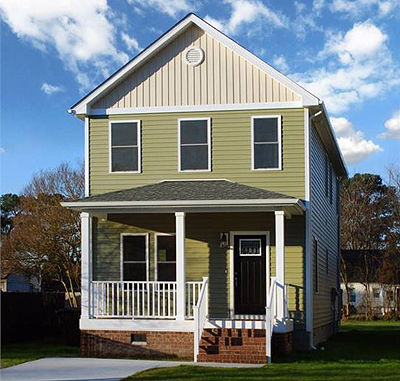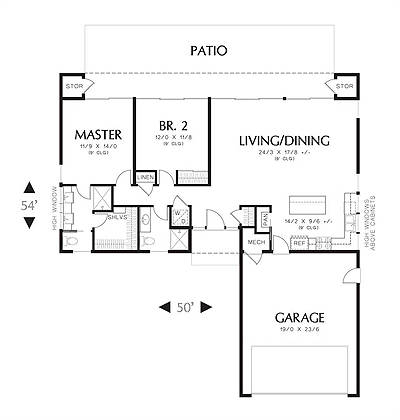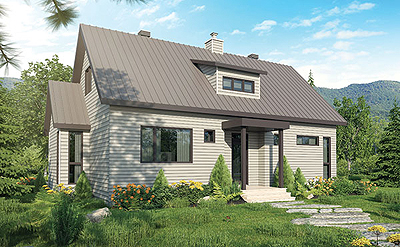How to Build an Affordable Home
by Alexis Thomas, Contributing Writer for Direct from the Designers™
Affordability in a home is very important, because you don't want to get stuck with a home you can’t afford. Many aspiring homeowners shop on the market, but building yourself can allow you to create a home that suits your budget better. And for a lot of our customers, it's worth the wait! Building a home allows you to prioritize for yourself, and you can upgrade certain things later on when you have the money, if you want to limit your borrowing. It might seem like a lot to take on, but we have tons of customers who love their affordable dream homes!
You can start with the same questions that any home shopper would—how many bedrooms and bathrooms do you need, do you want a garage, etc. But deciding those is just the start! Here are some reasons why you should consider building an affordable home rather than buying an existing one:
- You are in control of the final product.
- Your budget, your rules! You can invest in the parts that make the most sense to you.
- With new HVAC and appliances, you should have less maintenance and better efficiency.
- New construction can help you avoid toxins like mold and lead paint.
Take the time to think about building a new home, and if it's the right choice for you. It can be scary to make the leap, but with a good general contractor, it can be one of the most rewarding things you do! Read on to learn more about how you can build an affordable home from scratch.

House Shape
If you are prioritizing affordability, building a two-story home is a great choice. The most expensive parts of building are the foundation and the roof, so why not condense your square footage into two stories? But no matter how many stories you want, try sticking to a simple house shape—look for the most rectangular footprint when you shop! It's also smart to keep your roof simple, because complex lines drastically increase the cost of the roof. In short, the simpler the house, the more affordable it is; a complex house shape requires more materials and time to construct, and that results in a higher bill.
Insulation
It's smart to spend more money on insulation when you build, in order to save on utilities in the future. Having a well-insulated house will help save energy over the years, and you can even save money up front because it allows you to buy smaller A/C and heating systems for the house. Skimping on insulation often results in leaks, and that results in drafts that you feel and your HVAC system will have to work against. This isn't a place to cut corners!
Appliances and Fixtures
Everybody assumes you have to go all-in on a matching suite of kitchen appliances, but you don't have to if it saves money! For instance, you might get the range you really want if you love cooking, and opt for less expensive appliances elsewhere. Some even mix different brands to save money. Focus on functionality first, and it'll be easier to make the right decisions for your needs. If you want a more cohesive look, you can always match the finish, but it's also cool to have one key piece pop out, anyway!
The same goes for fixtures, everything from faucets to lighting. Luckily, the less expensive finishes are usually universally attractive, so you don't have to worry about clashing. Kitchens and bathrooms are the most expensive parts inside your house—limiting the cost of your fixtures will result in a huge savings in the overall price tag.

Interior
Want to maximize the space you have inside, without opting for more square footage that'll cost more indefinitely? Try getting large picture windows to make the room appear bigger; with good energy-efficient windows, they can actually help you cut utility costs! You can also opt for an open floor plan, not only to get a more spacious feeling, but to make it easier to entertain. You don't have to give up hosting even with a more affordable home, if it has the right layout.
Also, be honest about what your family needs in terms of bedrooms or bathrooms. It's easy to get sucked into buying more than you need, but remember that bathrooms are expensive to finish, and every square foot will affect HVAC and electricity costs. The average homeowner doesn't need a guest bedroom, or a third full bath. Don't get carried away!
Land
If you already have property to build a house on, think about where you want to build on it, how many trees need to be torn down, and if soil conditions are favorable for the foundation you want, where you want it. Gather your information, consider your options, and prepare accordingly. It'll cost money to get the information, but it's better than getting in over your head and being surprised by unforeseen circumstances that were there all along.
If you are looking to buy land to build a house on, consider these things:
- Is the land empty or full of trees and shrubs that need to be cleared?
- Does the land have hills, is it sloped, or does it need to be evened out?
- How much money will it cost to put a foundation on this particular lot?
Go over these questions, do some research on lots, ask for data, and talk to a contractor about how much the foundation will cost. All other things being equal (the town you live in, the size of your lot, the house you build, how you finish the house, etc.), it can cost significantly more to build on one lot over another. Be an informed customer and buy wisely!

Energy Saving
Saving energy starts with insulation, but it goes much further. Look for ENERGY STAR® appliances when you shop to save electricity. There are also many different bathroom features you can look at for saving water; look for WaterSense labels, and consider getting sink faucets with sensors, so they turn on and off automatically to limit waste. Saving resources isn't just good for the planet—it's great for your wallet!
If you want to take a more proactive approach, solar panels are a very easy way to start saving energy and money. A typical family spends thousands of dollars a year on electricity, and while solar panels cost more up front, they save money over time. There are also lease options if you can't afford to buy panels yourself, but your return on investment is much less. Look into tax breaks that can help make solar more affordable if you'd like to own yourself.
*Tip: There are some items that are easy to buy or replace later, so you can save up for them after you move in. Solar panels are easy to retrofit, but you can also hold off on things like built-ins, and trade up appliances and fixtures later. You can lay out a plan and a timeline to achieve your dream home, even if it isn't right now.
As always, no matter your goals, it's great to start the conversation with a contractor who can help you build an affordable home. Be up front about budget, and professionals can help steer you in the right direction, and they might have money-saving options you didn't even know about!
BROWSE HOME PRODUCT ARTICLES
- Creating a Spa-Like Master Bathroom »
- Designing a Water-Efficient Bathroom »
- Design a Modern Bathroom »
- View All Bathroom Articles »
- Building a New Home »
- Building a Duplex »
- Finding the Right Home Builder »
- View All Building Tips Articles »
- Adding the Right Columns»
- Decorative Touches for Your Interior»
- Shutters for Every Architectural Style »
- View All Columns & Millwork Articles »
- How to Use Specialty Laminates »
- Decorative Touches for Your Home's Interior
- View All Countertops and Surfaces Articles »
- What Goes Into a Great Deck? »
- Decorative Touches for Your Home's Interior »
- View All Decking Articles »
- Choosing Glass for Your Entry »
- Stylish Personas for Your Front Door »
- Using Sidelites and Transoms »
- View All Door Articles »
- Choose Siding for Your Region »
- Get the Most Out of Exterior Paint »
- Mixing Siding to Define Your Exterior »
- View All Exterior Articles »
- Finding the Right Home Builder »
- The Appeal of Small House Plans »
- Choosing the Perfect Floor Plan »
- View All Finding a Home Plan Articles »
- Colorful Flooring for Your Home »
- Designing With Different Widths»
- Chic, Neutral, Gray Flooring »
- View All Flooring Articles »
- Garage Doors That Add Curb Appeal »
- Caring for Your Garage Doors »
- Benefits of Insulated Garage Doors »
- View All Garage Door Articles »
- Reclaimed Products for Your Home »
- Building a Green and Stylish Home »
- Benefits of Building with SIPS »
- View All Green Building Articles »
- Cool Gadgets for Your New Home »
- Creating a Hi-Tech Home »
- Efficient Gifts for New Homeowners »
- View All Home Electronics Articles »
- Improve Your Home's Air Circulation »
- How to Improve the Air Circulation in Your Home »
- View All HVAC Articles »
- Bedrooms Designed for Sleep »
- Selecting a Fireplace for Your Home »
- Crafting a Luxurious Master Suite »
- View All Interior Design Articles »
- Design the Perfect Outdoor Space »
- Dive into a Beautiful Pool »
- Design a Sizzling Outdoor Kitchen »
- View All Outdoor Living Articles »
- Apps to Help You Pick Paint Colors »
- Create the Perfect Mood with Paint »
- How to Read the Color Wheel »
- View All Painting & Decorating Articles»
- Creating a Spa-Like Master Bathroom »
- High-Impact Kitchen Upgrades »
- Creating a Water Efficient Bathroom »
- View All Plumbing Fixtures Articles»
- Cladding That Complements Your Exterior »
- Reasons to Consider Prefinished Siding »
- View All Siding & Cladding Articles»
- All About Solar Powered Skylights »
- Natural Lighting for the Dark Corners of Your Home »
- Design a Better Bedroom with Skylights »
- View All Skylight Articles»
.png)
.png)
